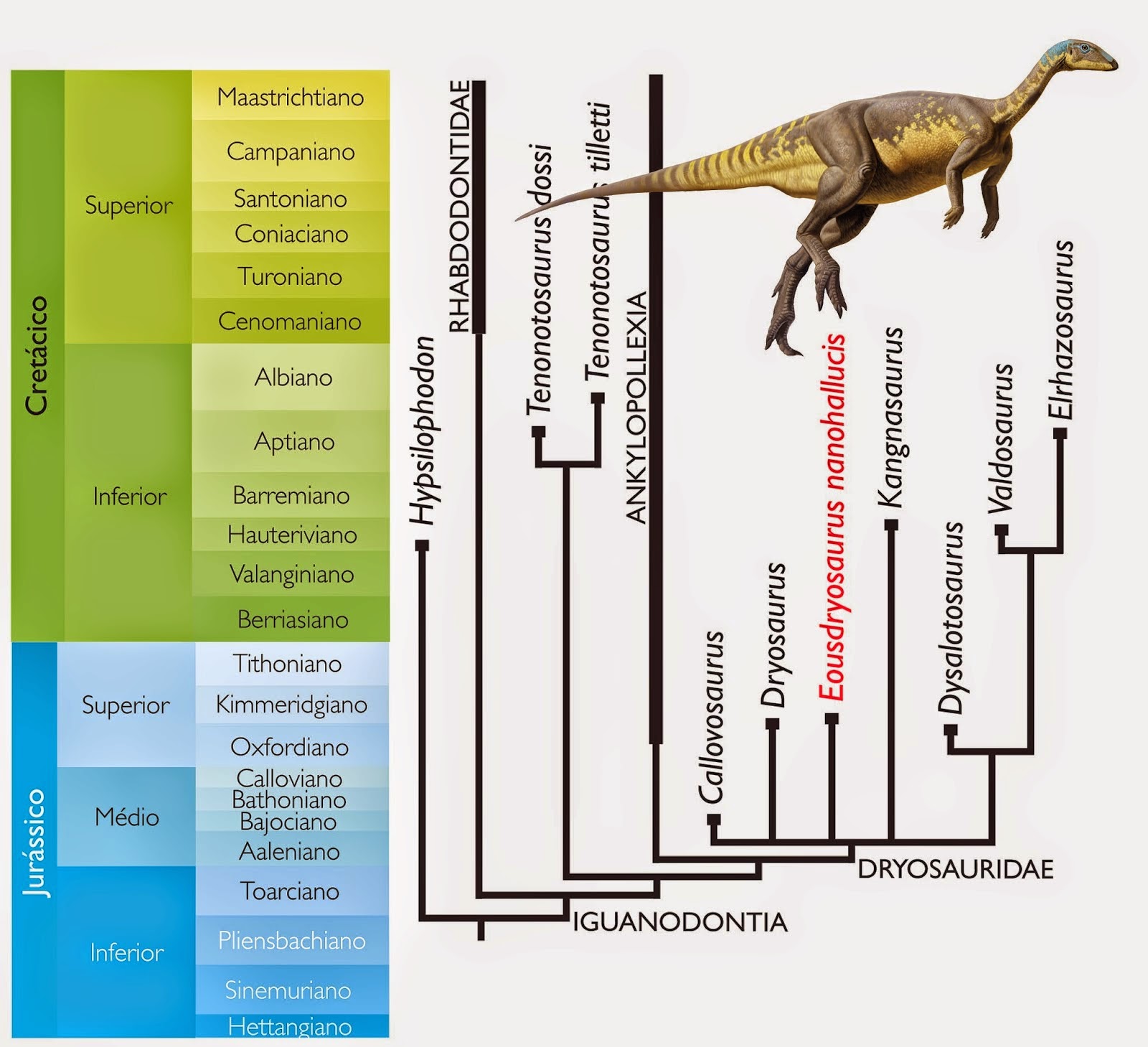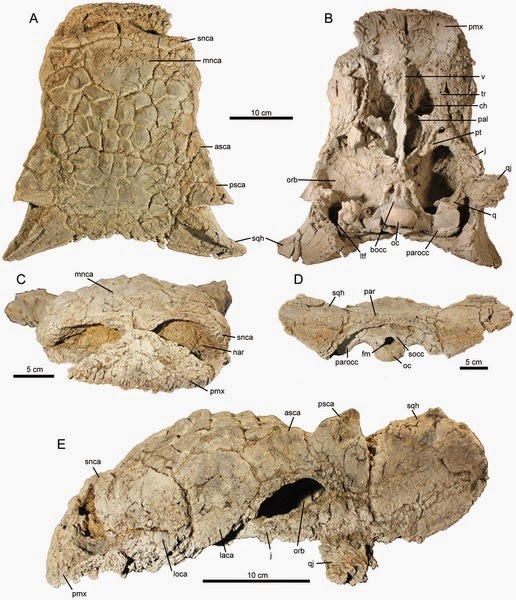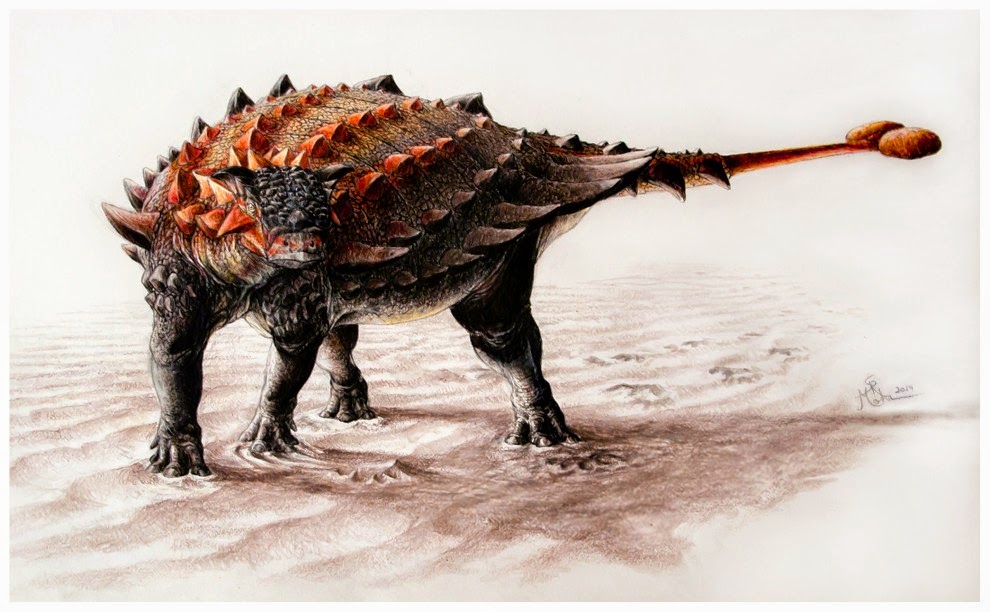[Most Recent Entries] [Calendar View]
Saturday, September 27th, 2014
| Time | Event | ||||||||
| 9:16a | [Paleontology • 2014] Eousdryosaurus nanohallucis • A New dryosaurid Ornithopod (Dinosauria, Ornithischia) from the Late Jurassic of Portugal
ABSTRACT A new dryosaurid ornithopod, Eousdryosaurus nanohallucis, gen. et sp. nov., is described here based on a single specimen from the Late Jurassic Alcobaça Formation of Portugal. Eousdryosaurus nanohallucis is distinguished from all other dryosaurids by eight autapomorphic features and an unique combination of characters, some of which are also shared by other dryosaurids. Eousdryosaurus is linked with Dryosauridae, because the fourth trochanter is proximally placed and widely separated from the scar for the insertion of the M. caudifemoralis longus, which is restricted to the medial surface of the femoral shaft. Phylogenetic analysis nests Eousdryosaurus in an unresolved polytomy at the base of Dryosauridae together with Callovosaurus, Dryosaurus, and Kangnasaurus. The complete pes of Eousdryosaurus, which has a phalangeal formula of 1-3-4-5-0, supports the putative autapomorphic reduction of the dryosaurid pes that also occurs in parallel in more derived ornithopods. Fernando Escaso, Francisco Ortega, Pedro Dantas, Elisabete Malafaia, Bruno Silva, José M. Gasulla, Pedro Mocho, Iván Narváez & José L. Sanz. 2014. A New dryosaurid Ornithopod (Dinosauria, Ornithischia) from the Late Jurassic of Portugal. Journal of Vertebrate Paleontology. 34(5): 1102 - 1112. doi: dx.doi.org/10.1080/02724634.2014.849715. | ||||||||
| 9:21a | [Paleontology • 2014] Eousdryosarus nanohallucis • A New dryosaurid Ornithopod (Dinosauria, Ornithischia) from the Late Jurassic of Portugal
ABSTRACT A new dryosaurid ornithopod, Eousdryosaurus nanohallucis, gen. et sp. nov., is described here based on a single specimen from the Late Jurassic Alcobaça Formation of Portugal. Eousdryosaurus nanohallucis is distinguished from all other dryosaurids by eight autapomorphic features and an unique combination of characters, some of which are also shared by other dryosaurids. Eousdryosaurus is linked with Dryosauridae, because the fourth trochanter is proximally placed and widely separated from the scar for the insertion of the M. caudifemoralis longus, which is restricted to the medial surface of the femoral shaft. Phylogenetic analysis nests Eousdryosaurus in an unresolved polytomy at the base of Dryosauridae together with Callovosaurus, Dryosaurus, and Kangnasaurus. The complete pes of Eousdryosaurus, which has a phalangeal formula of 1-3-4-5-0, supports the putative autapomorphic reduction of the dryosaurid pes that also occurs in parallel in more derived ornithopods. Fernando Escaso, Francisco Ortega, Pedro Dantas, Elisabete Malafaia, Bruno Silva, José M. Gasulla, Pedro Mocho, Iván Narváez & José L. Sanz. 2014. A New dryosaurid Ornithopod (Dinosauria, Ornithischia) from the Late Jurassic of Portugal. Journal of Vertebrate Paleontology. 34(5): 1102 - 1112. doi: dx.doi.org/10.1080/02724634.2014.849715. | ||||||||
| 4:16p | [Paleontology • 2014] Ziapelta sanjuanensis • A New Ankylosaurid Dinosaur from the Upper Cretaceous (Kirtlandian) of New Mexico with Implications for Ankylosaurid Diversity in the Upper Cretaceous of Western North America
Abstract A new ankylosaurid (Ankylosauria: Dinosauria), Ziapelta sanjuanensis, gen. et sp. nov., is based on a complete skull, an incomplete first cervical half ring, a possible fragment of the second cervical half ring, and additional fragmentary osteoderms. The holotype specimen is from the Upper Cretaceous (Upper Campanian, Kirtlandian Land-Vertebrate Age) Kirtland Formation (De-na-zin Member) at Hunter Wash, San Juan Basin, in northwestern New Mexico, USA. Diagnostic characters of Ziapelta include: a large, prominent triangular median nasal caputegulum; a mixture of flat and bulbous frontonasal caputegulae; ventrolaterally oriented squamosal horns with a sharp, prominent dorsal keel; and the ventral surface of basicranium with three prominent anteroposteriorly oriented fossae. A phylogenetic analysis suggests that Ziapelta is not closely related to the other ankylosaurid from the De-na-zin Member, Nodocephalosaurus, but allies it to the northern North American ankylosaurids Ankylosaurus, Anodontosaurus, Euoplocephalus, Dyoplosaurus, and Scolosaurus.
Systematic Paleontology Dinosauria Owen, 1842 Ornithischia Seeley, 1888 Thyreophora Nopcsa, 1915 Ankylosauria Osborn, 1923 Ankylosauridae Brown, 1908 Ziapelta gen. nov. Type and only known species. Ziapelta sanjuanensis sp. nov. Etymology. Zia, after the Zia sun symbol, a stylized sun with four groups of rays, having religious significance to the Zia people of New Mexico, and the iconic symbol on the state flag of New Mexico; pelta (Latin), a small shield, in reference to the osteoderms found on all ankylosaurids; sanjuanensis, In reference to San Juan County and the structural basin from which the specimen was derived.
Victoria M. Arbour, Michael E. Burns, Robert M. Sullivan, Spencer G. Lucas, Amanda K. Cantrell, Joshua Fry and Thomas L. Suazo. 2014. A New Ankylosaurid Dinosaur from the Upper Cretaceous (Kirtlandian) of New Mexico with Implications for Ankylosaurid Diversity in the Upper Cretaceous of Western North America. PLoS ONE. 9, 9: e108804. doi: dx.doi.org/10.1371/journal.pone.0108804 New dinosaur from New Mexico has relatives in Alberta http://uofa.ualberta.ca/news-and-events/n |
| << Previous Day |
2014/09/27 [Calendar] |
Next Day >> |







